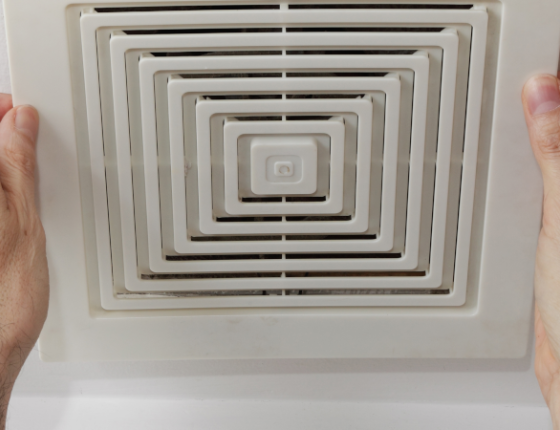Home Ventilation: A Guide to Exhaust Fans
A ventilation system is a key way to ensure that your home is a healthy one.
Why ventilate my home?
While CEE is dedicated to helping people make their homes more energy efficient, we also want people to live in homes that are safe, healthy and that have good indoor air quality.
According to the Minnesota Department of Commerce’s Division of Energy Resources, “Good indoor air quality is important for a healthy home. Proper and efficient ventilation removes unhealthy contaminants (such as smoke from cooking, moisture from bathing, or combustion products from heating systems) and brings fresh air into the living spaces.”
Homes without proper ventilation can experience a variety of problems with indoor moisture, odors, and pollutants. Moisture from cooking and bathing needs to be removed before high humidity levels lead to mold growth or physical damage to the home. Too little ventilation can allow unpleasant odors to linger. Contaminants like formaldehyde and volatile organic compounds can accumulate and may cause health problems in poorly ventilated homes.
Typically, newer or recently air-sealed homes have less natural ventilation from things like gaps and openings around doors, windows, and the home’s foundation, which means pollutants aren’t regularly flushed out of the home. The issue isn’t that these homes are too “tight” — it’s that they are not “breathing” properly. Mechanical ventilation, in the form of exhaust fans, allows homeowners to better control the breathability of their home.
Watch the following video for a brief explanation of the importance of insulation and ventilation.
When should I add ventilation to my home?
Many people add ventilation during an insulation or air sealing project because the air sealing work will restrict how a home breathes. Ask your insulation contractor to include ventilation in your project.
If you already have insulation and you need ventilation, typically an insulation contractor can install a ventilation fan, but for some cities a licensed HVAC contractor is required. If you need help determining the correct installer contact CEE's Energy advisors using the "Ask Us" button below.
If you would like help determining if ventilation is the right solution for your home, consider having an energy audit. Your utilities may provide this service.
What type of ventilation do you recommend?
For many existing homes, exhaust systems are an effective way to ventilate. Exhaust systems only remove air from your home, where as balanced systems like those described below both remove air and bring in fresh air from outside.
CEE recommends that you install an ENERGY STAR-rated bathroom exhaust fan or kitchen range hood that is also rated for quiet and continuous operation. This means the fan can run at a low level all the time and run at a higher level when needed.
A common location for a continuous ventilation fan is the most frequently used bathroom. It should replace any fan already in the room. If a home’s structure doesn’t allow for installation of such a fan in the bathroom, sometimes a kitchen range hood rated for continuous use is an option.. In most cases, one continuously ventilating fan — either in the bathroom or kitchen — is enough.
The fan installer can set the fan speed depending on the number of occupants or bedrooms and the home’s tightness. Your fan speed is based on these specific conditions to ensure that moisture and indoor air pollutants don’t build up in your home over time.
The default speed for these fans is typically 30 to 50 cubic feet per minute (CFM). Bathing or cooking will automatically turn it to the higher speed setting for 20 to 30 minutes. The higher speed is typically 50 – 100 CFM for a bath fan and more than 100 CFM for a kitchen fan.
How much does it cost to install?
Fan installation for an ENERGY STAR continuous operating fan typically costs between $1,100 - $1,600.
Can I leave my current fan switched to “on” instead?
It is not a good idea to leave your current fan on all the time instead of installing a new continuously running run, because the motors are not designed to be left on all the time and may breakdown. Once this happens, you would need to switch the fan out anyway. Additionally, older fans are louder than continuous rated fans.
How much will it cost to run the fan all the time?
We recommend running the fan continuously, 24/7. By running it all the time, the fan can be set at a lower, quieter speed. It typically costs $7 – $15 per year in electricity to operate the fan this way. Additionally, the continuous fan will exhaust a very small amount of already heated or cooled air from the home.
While this may sound counterproductive at first, adding ventilation is overall very beneficial. It goes a long way toward preventing structural damage to your home and health issues for you and your family, both of which would cost more than adding a ventilation system.
If you add a continuous fan as a part of an insulation project, know that the savings from air sealing and insulation work are typically much greater than the small amount of air the fan removes from the home.
How do I adjust the fan settings?
Usually you can change fan settings by removing the grate and adjusting the dials. Typically, one dial will adjust the speed and the other will determine how long the fan will remain on after being triggered by motion or a wall switch. Some fans may have an external speed switch as well.
You can increase the speed of the fan when it is humid inside or when there are odors in the home. In a bathroom, the fan may stay on longer if it is unable to keep the room dry.
What maintenance is required?
With most fans, you should clean the grill and fan body yearly. Follow the cleaning timeline for your specific model, as outlined by your fan installer.
What are recommended humidity levels?
Moisture from cooking and bathing needs to be removed before high humidity levels lead to mold growth or physical damage to the home.
|
When the Outdoor Temperature Is (deg. F): |
The Relative Humidity Should Be: |
|---|---|
|
20 to 40 |
< 40% |
|
10 to 20 |
< 35% |
|
0 to 10 |
< 30% |
|
-10 to 0 |
< 25% |
|
-20 to -10 |
< 20% |
|
-20 or below |
< 15% |
What are HRVs and ERVs?

Heat Recovery Ventilators (HRVs) and Energy Recovery Ventilators (ERVs) are types of ventilation machines, typically tied into the ductwork for the forced air furnace and central air conditioning. The key advantages of both HRVs and ERVs compared to exhaust-only continuous ventilation, are that they can recover heat from the warm air they remove from your home and provide good filtration for allergens.
The main difference between HRVs and ERVs is that HRVs remove humidity from the air stream, while ERVs recover humidity from the air stream. The installation cost of HRVs and ERVs can be two to four times more than a continuous bath fan—usually between $1500 and $2500. Prices vary, so be sure to check with your HVAC contractor for more details on pricing and installation.
Given their higher installation cost, you should consider an HRV or ERV when a bath fan or kitchen hood fan is not sufficient to ventilate a home and when the home already has ductwork. Typically this means that HRVs and ERVs are installed in new or extremely well-sealed homes.

